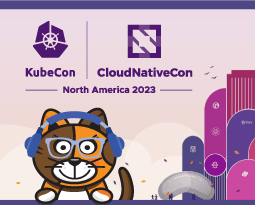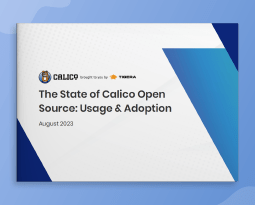Calico monthly roundup: October 2023
Welcome to the Calico monthly roundup: October edition! From open source news to live events, we have exciting updates to share—let’s get into it!
Join us at KubeCon + CloudNativeCon North America 2023
We’re gearing up for KubeCon + CloudNativeCon 2023 in Chicago. Join us at booth #G13 for exciting Kubernetes security updates and pick up some cool new Calico swag! |
Customer case study: eHealth
Calico provides visibility and zero-trust security controls for eHealth on Amazon EKS. Read our new case study to find out how. |
|
Learn why a traditional firewall architecture doesn’t work for modern cloud-native applications and results in a huge resource drain in a production environment. |

The State of Calico Open Source: Usage & Adoption Report 2023 Get insights into Calico’s adoption across container and Kubernetes environments, in terms of platforms, data planes, and policies. |
Open source news
- Read stories of Calico Open Source in action from our Calico Big Cats
- Share your Calico Open Source journey and win Continue reading
HN708: The Future Of Networking With Brad Casemore – Part 1
The Future of Networking series continues with Brad Casemore, who survived multiple decades in the technology sector, including sixteen years as an analyst for IDC. He's been a longtime observer of networking markets, technologies, and trends. We talk about the interest in AI and try to separate the hype from the reality, multi-cloud networking, and more.
The post HN708: The Future Of Networking With Brad Casemore – Part 1 appeared first on Packet Pushers.
HN708: The Future Of Networking With Brad Casemore – Part 1
The Future of Networking series continues with Brad Casemore, who survived multiple decades in the technology sector, including sixteen years as an analyst for IDC. He’s been a longtime observer of networking markets, technologies, and trends. Recently retired from the analyst business, we’ve invited Brad onto the show as a kind of exit interview to... Read more »How IIoT Networks Use SD-WAN: Navigating the Right Path for Sensors
Industrial Internet of Things sensors can use SD-WAN to securely transmit data to improve central management, optimize supply chains, and achieve more robust access control.Video: Hacking BGP for Fun and Profit
At least some people learn from others’ mistakes: using the concepts proven by some well-publicized BGP leaks, malicious actors quickly figured out how to hijack BGP prefixes for fun and profit.
Fortunately, those shenanigans wouldn’t spread as far today as they did in the past – according to RoVista, most of the largest networks block the prefixes Route Origin Validation (ROV) marks as invalid.
Notes:
- ROV cannot stop all the hijacks, but it can identify more-specific-prefixes hijacks (assuming the origin AS did their job right).
- You’ll find more Network Security Fallacies videos in the How Networks Really Work webinar.
Video: Hacking BGP for Fun and Profit
At least some people learn from others’ mistakes: using the concepts proven by some well-publicized BGP leaks, malicious actors quickly figured out how to hijack BGP prefixes for fun and profit.
Fortunately, those shenanigans wouldn’t spread as far today as they did in the past – according to RoVista, most of the largest networks block the prefixes Route Origin Validation (ROV) marks as invalid.
Notes:
- ROV cannot stop all the hijacks, but it can identify more-specific-prefixes hijacks (assuming the origin AS did their job right).
- You’ll find more Network Security Fallacies videos in the How Networks Really Work webinar.
Unlocking IT Success: Navigating Talent Shortages with Integrated Solutions
Integrated solutions help overcome IT talent shortages, streamline IT operations, reduce costs, and empower existing talent.KU039: Prepping For KubeCon North America 2023
Grab a rundown of what to expect at KubeCon NA this year as Kubernetes Unpacked co-host Michael Levan prepares to hit the conference floor.
The post KU039: Prepping For KubeCon North America 2023 appeared first on Packet Pushers.
KU039: Prepping For KubeCon North America 2023
The KubeCon excitement is catching as Michael Levan gets ready to attend for the first time. Grab a rundown of what to expect at the North American event this year as he and Kristina Devochko review sessions and provide advice on how to tackle the massive amount of content that’s on the schedule. A strong... Read more »Hedge 201: Roundtable
It’s time to gather round the hedge and discuss whatever Eyvonne, Tom, and Russ find interesting! In this episode we discuss business logic vulnerabilities, and how we often forget to think outside the box to understand the attack surfaces that matter. We also discuss upcoming network speed increases like Wi-Fi 7 and 800G Ethernet. Do we really need these speeds, or are we just getting caught up in a hype cycle?
IPv6 Buzz 138: Making Sense Of DHCPv6 Prefix Delegation (DHCPv6-PD)
DHCPv6 Prefix Delegation (DHCPv6-PD) is an IETF RFC that lets a router delegate a long-lived prefix, using DHCP, to a requesting router. The hosts discuss how this is used today both by service providers and in the enterprise, and potential impacts on address allocation and planning.
The post IPv6 Buzz 138: Making Sense Of DHCPv6 Prefix Delegation (DHCPv6-PD) appeared first on Packet Pushers.
 Evaluating container firewalls for Kubernetes network security
Evaluating container firewalls for Kubernetes network security